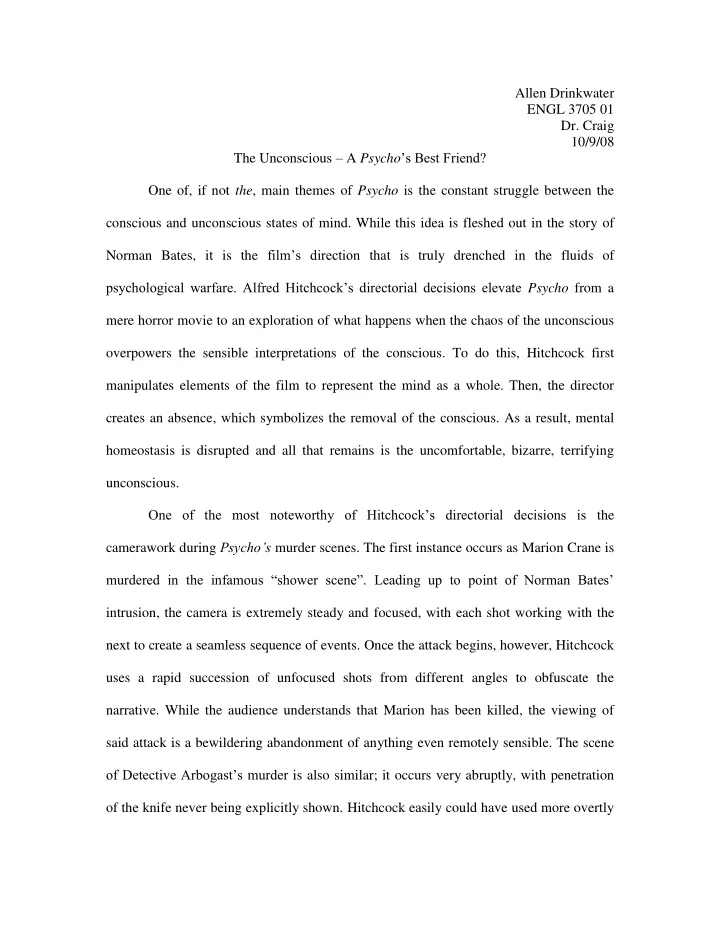

Allen Drinkwater ENGL 3705 01 Dr. Craig 10/9/08 The Unconscious – A Psycho ’s Best Friend? One of, if not the , main themes of Psycho is the constant struggle between the conscious and unconscious states of mind. While this idea is fleshed out in the story of Norman Bates, it is the film’s direction that is truly drenched in the fluids of psychological warfare. Alfred Hitchcock’s directorial decisions elevate Psycho from a mere horror movie to an exploration of what happens when the chaos of the unconscious overpowers the sensible interpretations of the conscious. To do this, Hitchcock first manipulates elements of the film to represent the mind as a whole. Then, the director creates an absence, which symbolizes the removal of the conscious. As a result, mental homeostasis is disrupted and all that remains is the uncomfortable, bizarre, terrifying unconscious. One of the most noteworthy of Hitchcock’s directorial decisions is the camerawork during Psycho’s murder scenes. The first instance occurs as Marion Crane is murdered in the infamous “shower scene”. Leading up to point of Norman Bates’ intrusion, the camera is extremely steady and focused, with each shot working with the next to create a seamless sequence of events. Once the attack begins, however, Hitchcock uses a rapid succession of unfocused shots from different angles to obfuscate the narrative. While the audience understands that Marion has been killed, the viewing of said attack is a bewildering abandonment of anything even remotely sensible. The scene of Detective Arbogast’s murder is also similar; it occurs very abruptly, with penetration of the knife never being explicitly shown. Hitchcock easily could have used more overtly
fatal depictions, but it is in their absence that a departing from the conscious occurs - the transition into ambiguity mirrors the embracing of the unconscious. Another choice of the director that facilitates Psycho ’s examination of conflicting mental subdivisions is the use of Bernard Herrman’s score. As evidenced in opening credits, Herrman’s score simultaneously makes use of beautiful, sweeping melodies and hauntingly harsh, accented, staccato notes. The two distinct musical accompaniments form Psycho ’s theme as a whole, just as the conscious and unconscious are two parts of the same mind. With this in mind, it seems reasonable to suggest that a lack of melody from the film’s score signifies the absence of the conscious, and therefore an ascendancy of the unconscious. In essence, it is no coincidence that short, dissonant quarter notes with no melody complement the instances in which the conscious is most obviously overwhelmed by the unconscious. Lastly, Hitchcock sullies the collective conscious of Psycho ’s viewers by killing Marion one-third of the way into the film. Up until her death, Marion serves as an anchor for the audience, providing them with the hope that sense will be made of the bizarre complications. Hitchcock made a very thoughtful decision when he cast a recognizable actress as Marion, gave her enough screen time to be perceived as the protagonist, and then killed her before the fifty-minute mark. As a result, the rug is swept out from under the audience, stability is virtually nonexistent, and a confrontation with the horrifying unknown that is the unconscious is imminent.
Psycho Presentation – Notes Overview – Hitchcock manipulates elements of his film to give the audience the feeling of unified whole – such as the unified whole of a mind. At certain points, he creates an absence, which is comparable a forfeiting of the conscious – the means of expressing reality in safe, understandable terms. All that the audience has left to deal with is the unconscious – the shocking, disjointed, terrifying unknown So really, uses directorial status to disrupt mental homeostasis. 1) Camerawork of Hitchcock – very deliberate, well planned; rotating, moving around, very focused. (CHAPTER 10 – 46 Mins) - Not the case during the murder scenes. Marion’s murder – rapid succession of cuts, very disjointed, unfocused - Arbogast’s murder is al so not clear - Question: What’s more important, the story, or how it is told? 2) Music Two halves – soft, legato music on top of rigid, haunting staccato patterns - Sometimes just the soft portion of the whole is used – coping with reality as possible (CHAPTER 2 – 2 Mins) as best - When all melody is sacrificed, it is an ugly, terrible quality of life to deal (CHAPTER 17 – 1 Hour 16 Mins) with Question: Do you consider the music of a film to be integral? Or is it just an added bonus? 3) Ma rion’s death Built up as a force against evil – takes corrupt man’s money for her own Willing to take on a sullied man At the time, Janet Leigh was super famous – 24 prior credits Hitchcock pulls rug out from under audience – destroys stability Question: Do you consider Marion a sympathetic character? If not, why? Are there any sympathetic characters?
Recommend
More recommend